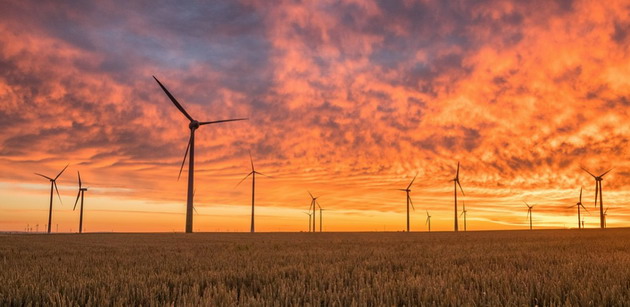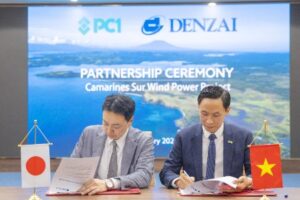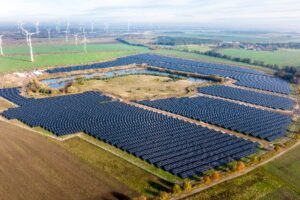Wind Energy Facts

Wind energy represents today a great source of renewable and clean power that can be harvested day and night by turning the kinetic energy of the wind into clean electricity with the help of wind turbines and generators.
In the last decade, wind power has become more popular among the investors in the energy sector, due to the decreasing prices and because wind power being clean and renewable, is considered an energy source of the future.
Today, the generation capacity for wind power expands both onshore and offshore because we need to slowly replace the dirty energy produce by fossil fuels with clean electricity produced by renewable energy sources such as wind, solar, geothermal, hydro, tidal, wave, biomass, etc.
The environment needs to be healed because both we and the future generations need to live in a healthy environment free of pollution and powered only by renewable resources.
Facts about Wind Energy
1. Is produced by the wind
In order to produce wind power, a wind turbine is using the kinetic energy of the wind, which is first turned into mechanical energy (the rotating turbine) and then into clean electricity using a generator.
2. Is used by mankind from ancient times
Mankind has used the power of the wind from antiquity in the transportation sector (to sail boats on the sea), and in the agricultural sector (windmills were used to pump water and to grind grain).
Today, we are using the power of the wind to generate clean electricity day and night, both onshore and offshore.
3. Is a renewable energy source
The wind on our planet is produced by the Sun, which is considered a renewable resource because compared to the time spent by mankind here on Earth is considered a continuous source of clean energy.
The Sun heats the air layers in our atmosphere in an uneven way, which makes the layer of warm air to rise up in the atmosphere, and the layers of cold air to go down in the atmosphere.
This movement of the different air layers in the atmosphere is the wind, which is nowadays used by mankind to generate clean power.
The Sun will be here sending us heat and light for another 5 billion years, and when the hydrogen will run out, our star will start fusing helium with heavier elements until will completely consume the fuel.
4. Is a clean source of electricity
All the wind turbines used today to generate clean electricity (both horizontal and vertical turbines) produce energy without releasing any harmful emissions into the atmosphere, which means that they are generating clean power.
Representing a clean source of power, wind energy is an energy source of the future.
5. Several European countries rely on wind energy as a main source of power in their energy mix
Many countries in the European Union rely pretty much on wind energy.
Countries like Denmark, Estonia, Germany, Ireland, Greece, Romania, Spain and Lithuania already rely on wind energy and have covered about 11.6% of the EU’s electricity consumption in 2017.
Wind power is well developed in the UK too, where in terms of renewables, wind energy is on the second place in terms of electricity generation after biomass.
6. Is a free source of clean power
Being produced by the Sun, the wind represents a free energy resource, which can be harvested day and night to cover our energy needs.
The Sun will be here for another 5 billion years, so we can say that we have a great source of free and clean electricity at our disposal, which will successfully replace the dirty energy produced by fossil fuels.
7. Is a clean alternative to fossil fuels
Today, mankind relies mostly on energy produced by fossil fuels such as coal, oil and natural gas.
However, the generation capacity for wind power and other renewables increases year after year, and this is showing that mankind will rely less on fossil fuels and more on clean sources of power in the following decades.
8. Is a great asset for countries like the U.S., China and Germany
Wind power in the U.S. had an installed capacity of 82 GW in 2017.
The U.S. Department of Energy estimated that by 2030, wind power could cover about 20% of the electricity demand in the country.
China and the EU have overcome the U.S. in terms of wind power generation capacity.
The EU had at the end of 2017 an installed capacity of wind power of 169 GW, while China about 163 GW.
9. Has high installation costs
A large wind turbine comes with high installation costs, but giving the fact that once installed will generate clean electricity for at least 25 years, we can say that the financial effort worth it, and the turbine will cover its installation costs in the first six to eight months of service.
10. Offshore wind energy is expanding fast
At the end of 2017, offshore wind power accounted for 18 GW in installed capacity, and the largest offshore wind farms are located today in northern Europe, and were built by countries like the UK, Germany, the Netherlands, Denmark and others.
Wind Turbine and Wind Farm Facts
Wind turbines are used today to turn the kinetic energy of the wind into mechanical energy and then into clean electricity with the help of generators.
There are several types of wind turbines used today to generate electricity, but the most important ones are the horizontal axis wind turbines (used both onshore and offshore today), and the vertical axis wind turbines, which are smaller and are mostly used in residential areas.
1. Modern wind turbines have first appeared in the middle of the 20th century
The first modern wind turbine (a megawatt-class wind turbine that was synchronized to a utility grid) was built in 1941 in Vermont.
The Smith-Putnam wind turbine worked for only 1,100 hours before suffering a critical error.
The turbine was not repaired due to the lack of materials during the war.
However, the first utility grid-connected wind turbine was built in 1951 in the Orkney Islands (the UK) by John Brown & Company.
2. Offshore wind turbines are the largest in the world
The largest wind turbine created for offshore wind farms is the Vestas V164, which is a three-bladed wind turbine that was upgraded to 9 MW (from 8 MW before).
This horizontal axis wind turbine has an overall height of 722 ft (220 m), and the blades reach a diameter of 538 ft (164 m).
Even if it was introduced four years ago (in 2014), the Vestas V164 wind turbine is still the world’s largest-capacity wind turbine of today.
3. Onshore wind turbines can also reach a height of 60 stories
The largest onshore wind turbine today is the Enercon E-126, which is a three-bladed onshore horizontal axis wind turbine with an overall height of 650 ft (198 m) and a diameter of the blades reaching 413 ft (126 m).
This onshore wind turbine produces 7.58 MW and is the wind turbine with the largest capacity on land.
4. Wind turbines reduce the level of air pollution on the planet
A wind turbine with an installed power of only 1 MW will offset each year about 2,600 tons of carbon dioxide (CO2).
If we produce electricity using wind turbines, we are no longer polluting the environment like the coal, oil or natural gas-fired power stations that release harmful emissions into the atmosphere for each MW of electricity produced.
All wind turbines produce clean electricity without releasing harmful emissions into the atmosphere.
5. Wind farms are producing clean electricity without consuming water
A factory that builds wind turbines consumes little to no water, and a wind turbine that works day and night to generate clean electricity does not require water.
However, a coal-fired power station will consume a large volume of water to produce electricity.
If the US will reach 20% wind energy by 2030, it would save about 4 trillion gallons of water, which equals the annual consumption of about 9 million Americans.
6. Wind turbines does not pollute the water resources
Wind farms are producing clean electricity without polluting the air, the soil or the water resources.
Not even the offshore wind farms (that operate on the sea) are not polluting the marine water.
7. Wind turbines produce electricity even if they rotate slowly
A large wind turbine will generate clean power even if the blades of the rotor will spin slowly (at 15 to 20 RPM).
The technology also makes the turbine to spin and produce electricity even if the speed of the wind is low.
8. Wind farms help us to fight against climate change
Being a clean and renewable technology, all wind turbines are producing electricity without polluting the environment, and they also help us to offset billions of tons of harmful emissions every year.
Reducing the level of emissions produced yearly, wind farms are reducing the effects of global warming and climate change on the planet.
9. A wind turbine require less than 1 acre of land to operate
Even a very large wind turbine does not require more than 1 acre of land to operate in proper conditions.
In that 1 acre of land are included the wind turbine, and also the substation.
However, that land of 1 acre can still be used for farming.
10. One wind turbine can power a large number of households
A large 8 MW wind turbine (onshore or offshore) can power about 1,200 households, and equals about 32,000 solar panels (250 W panels).
Final conclusion
Wind energy is today the fastest growing technology on the planet mostly because the prices have dropped in the last decade and because we need to build a massive capacity for wind power generation for the green future that will follow.






